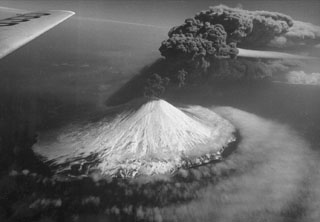Report on Alaid (Russia) — May 2016
Bulletin of the Global Volcanism Network, vol. 41, no. 5 (May 2016)
Managing Editor: Edward Venzke.
Research and preparation by Robert Andrews.
Alaid (Russia) Moderate eruption that began on 2 October 2015 continued into early 2016
Please cite this report as:
Global Volcanism Program, 2016. Report on Alaid (Russia) (Venzke, E., ed.). Bulletin of the Global Volcanism Network, 41:5. Smithsonian Institution. https://doi.org/10.5479/si.GVP.BGVN201605-290390
Alaid
Russia
50.861°N, 155.565°E; summit elev. 2285 m
All times are local (unless otherwise noted)
Alaid, a volcano off the southern tip of Russia's Kamchatka peninsula, erupted during October-December 2012, with several ash plumes, steam emissions, and frequent thermal anomalies (BGVN 38:10). A weak thermal anomaly was last detected in mid-December 2012. Eruptive activity resumed beginning in October 2015 and continued into early 2016. Alaid is monitored by the Kamchatka Volcanic Eruptions Response Team (KVERT).
KVERT noted that an intense thermal anomaly was identified in satellite data starting at 0305 on 2 October 2015, which was likely the onset of moderate Strombolian activity. Consequently, KVERT raised the Aviation Color Code to Yellow (the second lowest level on a four-color scale). The report also referred to a Tokyo VAAC notice from 29 September 2015, noting that KBGS RAS had detected increased seismicity at the volcano, though the VAAC notice only stated that a low-level "eruption" had been reported.
During 3 October-25 December 2015 often intense thermal anomalies were detected, though cloud cover often obscured views. Gas-and-steam emissions were first visible on 16 December. Observers on Paramushir Island (the nearest point on the island is 30 km SE of Alaid) indicated that emissions during 28-29 December 2015 contained a small amount of ash. The intensity of the thermal anomaly decreased considerably in January, and then continued to weaken in early February. Steam-and-gas emissions were reported weekly through 28 January 2016. KVERT lowered the Aviation Color Code to Green on 5 February.
Thermal anomalies, based on MODIS satellite instruments analyzed using the MODVOLC algorithm, were observed frequently (but not continuously) beginning on 5 October 2015 and continued through 4 January 2016. The MIROVA (Middle InfraRed Observation of Volcanic Activity) volcano hotspot detection system, also based on analysis of MODIS data, detected frequent hotspots from the beginning of October 2015 through the first week of January 2016, although one low-to-moderate energy hotspot was observed as late as 17 February 2016 about 4 km from the summit.
Geological Summary. The highest and northernmost volcano of the Kuril Islands, Alaid is a symmetrical stratovolcano when viewed from the north, but has a 1.5-km-wide summit crater that is breached open to the south. This basaltic to basaltic-andesite volcano is the northernmost of a chain constructed west of the main Kuril archipelago. Numerous pyroclastic cones are present the lower flanks, particularly on the NW and SE sides, including an offshore cone formed during the 1933-34 eruption. Strong explosive eruptions have occurred from the summit crater beginning in the 18th century. Reports of eruptions in 1770, 1789, 1821, 1829, 1843, 1848, and 1858 were considered incorrect by Gorshkov (1970). Explosive eruptions in 1790 and 1981 were among the largest reported in the Kuril Islands.
Information Contacts: Kamchatka Volcanic Eruptions Response Team (KVERT), Far East Division, Russian Academy of Sciences, 9 Piip Blvd., Petropavlovsk-Kamchatsky, 683006, Russia (URL: http://www.kscnet.ru/ivs/); Hawai'i Institute of Geophysics and Planetology (HIGP) MODVOLC Thermal Alerts System, School of Ocean and Earth Science and Technology (SOEST), Univ. of Hawai'i, 2525 Correa Road, Honolulu, HI 96822, USA (URL: 2/12/2016http://modis.higp.hawaii.edu/); MIROVA (Middle InfraRed Observation of Volcanic Activity), a collaborative project between the Universities of Turin and Florence (Italy) supported by the Centre for Volcanic Risk of the Italian Civil Protection Department (URL: http://www.mirovaweb.it/).

